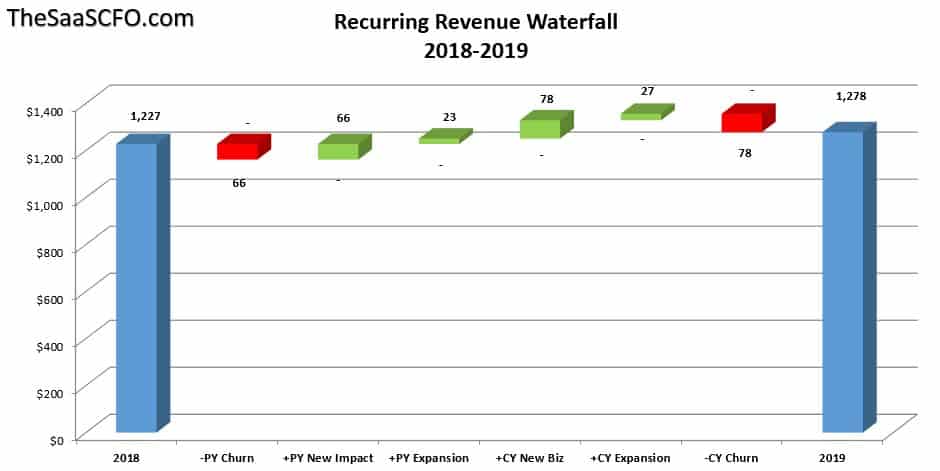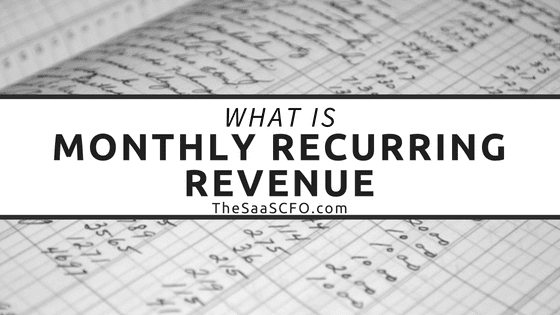Guide to Monthly Recurring Revenue (MRR)
There is no shortage of terms and acronyms in SaaS, and monthly recurring revenue (MRR) is one of them. SaaS revenue terms can be quite confusing, especially around recurring revenue. Is it MRR, ARR, ARPA, revenue recognition or bookings?
In this post, I’ll define monthly recurring revenue, its many uses, and how you calculate it. I’ll also explain some of the other similar MRR terms.
What is MRR?
I wish that I could say that MRR is definitively X, however, it has many meanings.
Let’s start from a revenue perspective. In relation to revenue, MRR is your monthly recognized revenue number. It is one month’s total of all your recurring revenue.

Annualize this number and you often get what is referred to as your Exit ARR (annual recurring revenue). Exit ARR is simply your current go-forward run rate of ARR. Check out my committed monthly recurring revenue post and how to turn exit ARR into a better forward-looking SaaS metric.
Invoicing SaaS Subscriptions
If you invoice monthly, then MRR is simply the total of all invoices that fell in that month. Since MRR is a monthly amount, you invoice and recognize MRR at the same time. However, if you have revenue recognition software in place, it will recognize revenue based on the days in the month.
If you think in terms of ARR and invoice annually, then MRR is the monthly recognized portion of your ARR subscriptions.
Careful: if you are on cash basis accounting, MRR is not all the annual or ARR invoices you posted to revenue that month! Proper SaaS revenue recognition must be applied to annual invoices.
Next, let’s look at the different layers of MRR.
Types of Monthly Recurring Revenue
MRR is not just one thing. There are many layers to MRR that make up your total MRR number for the month. If you invoice monthly, then each month you re-invoice your existing customers who didn’t churn, then invoice new customers added in the month and then account for any expansion, downgrades, and/or cancellations from existing customers.
New Business MRR – this is new revenue from new logos. You should track both dollars and logo counts.
Expansion MRR – this is new revenue from existing customers. Think add-ons or upsells.
Downgrade MRR – this is lost revenue from existing customers. Think lost seats or dropped modules.
Churn MRR – this is lost revenue from a customer completely leaving you. You should track both dollars and logo counts, so that you can calculate churn on a dollar retention and logo retention basis.
The screenshot below of my MRR waterfall is an example of a monthly recurring revenue formula from my SaaS Financial Plan. One note. If you forecast downgrades, it would also be included in the table below.

Recurring Revenue Waterfall
Or, if you are more visual, you can also chart each layer of MRR so that you can truly understand why your recurring revenue is moving up or down.
The data in this chart is more advanced to track, but trust me, if you can present this chart to your boss or investors, it shows that you understand all the components of your recurring revenue.
I like to describe this as a waterfall chart. You can download my monthly recurring revenue spreadsheet here to recreate this waterfall chart.

Software Bookings
Finally, you can think of MRR or ARR in bookings terms. I define a booking as simply an executed software contract.
Careful: a booking has nothing to do with recognized revenue!
A booking is not a GAAP/IFRS term, but bookings numbers are an important metric to track each month. You should track the MRR or ARR layers described above.
Monthly Recurring Revenue Definitions
MRR – From a revenue perspective, it is your monthly recognized revenue number. It is one month’s total of all your recurring revenue.
ARR – annual recurring revenue. This is typically referred to as bookings number, because you must recognize ARR invoices ratably each month. MRR is the result of the revenue recognition of ARR.
Booking – an executed software contract. A booking is not revenue (yet).
Exit ARR – annualize your MRR revenue number to calculate your total book of business. Key component in valuations.
Committed MRR or ARR – forward-looking SaaS metric that combines actual MRR or ARR data with known bookings and churn data.
ARPA – average revenue per account equals total MRR in a month divided by customers.
Summary
As you can see, there are many ways to slice and dice monthly recurring revenue. Ensure that you and your team are consistent with the usage of these terms (you all define them the same way) and that you track each component of MRR every month.
Please let me know below if you have any questions.
I have worked in finance and accounting for 25+ years. I’ve been a SaaS CFO for 8+ years and began my career in the FP&A function. I hold an active Tennessee CPA license and earned my undergraduate degree from the University of Colorado at Boulder and MBA from the University of Iowa. I offer coaching, fractional CFO services, and SaaS finance courses.

Agree that there are multiple definitions, but from what I’ve seen working in finance in the SaaS industry, both ARR and MRR are typically reflected in terms of bookings, which to your point represents the book of business at a given point in time.
We’ll typically show our cumulative bookings waterfall, and then separate from that show what our GAAP revenue, which we refer to as Subscription Revenue (not MRR). The distinction is important because GAAP/IFRS revenue typically is not as accurate of an indicator of your existing book of business at a given time (as revenue recognition has a lot of nuances – booking to launch delay, multiple element arrangements, contractual price increases, etc.).
GAAP revenue is definitely important, but most benchmarks/metrics (YoY growth, churn %, net retention %, etc.) are driven off of bookings, and that’s where your investors will focus as well.
What means MRR BB and MRR EB? Could not find this anywhere
Hi Fabian,
MRR EB = Monthly Recurring Revenue Ending Balance
MRR BB = Monthly Recurring Revenue Beginning Balance
Ben
In the NDR sheet, what does T3M stand for? and NEW ASP T3M
Hi Tom, T3M = trailing 3 months.